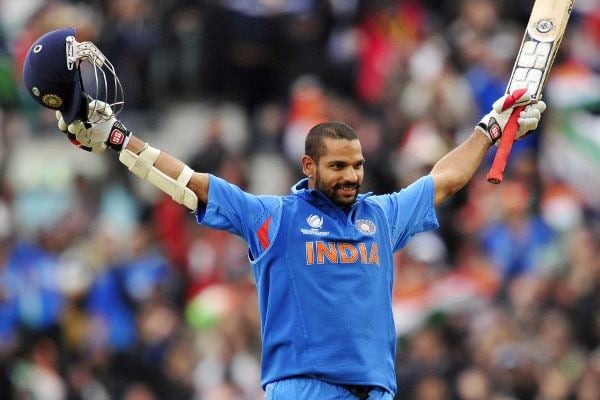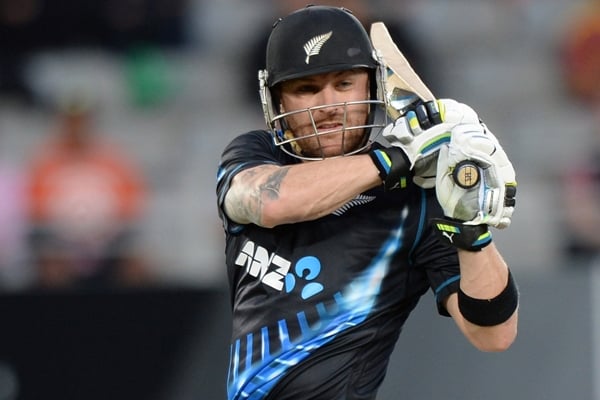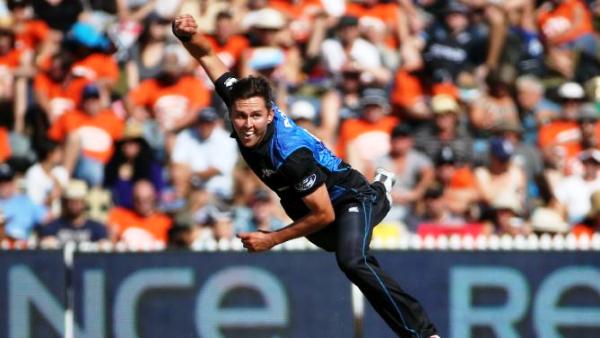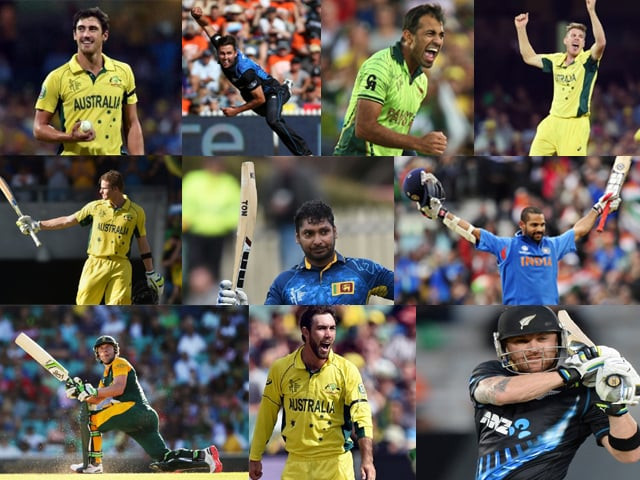What was promised to be a closely fought contest (judging by the previous meeting between these two sides in the group stage), turned out to be a highly one sided affair as New Zealand was bowled out for a miserly 183 runs in 45 overs, courtesy of superior left-arm fast bowling by the Australian contingent. As expected, the men in gold attacked from the word go, chasing down the puny target in less than 34 overs.
This is not the first time a World Cup final has been dominated by one side; Australia has been that side on four occasions now (1999, 2003, 2007 and 2015). However, the 11th edition of cricket’s grand festival has provided fans with a number of nail-biting encounters and a myriad of unforgettable performances from the very best in the game
In celebration of these individual accomplishments, listed below is a combined XI of superstars who rose to the big occasion and carved their names in World Cup history:
Shikhar Dhawan
India’s feisty opening batsman was having a disastrous summer Down Under before his fortunes took a 360 degree turn against Pakistan at the Adelaide Oval. A composed knock of 73 runs by Shikhar Dhawan helped India oust their arch rivals for the sixth consecutive time in World Cups.
However, it was India’s second World Cup game which truly marked their resurgence after a winless summer Down Under, as Dhawan smashed 137 against a highly formidable South African bowling attack. Dhawan went on to score another century against Ireland later on in the tournament, tallying up an aggregate of 412 runs in eight innings, at an average of 51.50. It can be argued that had Dhawan failed to find form at the right time, India might not have managed an undefeated run of seven games to the semi-final, where they crashed out of the tournament at the hands of eventual champions Australia.
 Shikhar Dhawan. Photo: AFP
Shikhar Dhawan. Photo: AFPBrendon McCullum (captain)
New Zealand’s captain and sportsman of the year might have gotten dismissed for a bronze duck in the World Cup final, but he has succeeded in inspiring a generation of cricketers and cricket watchers by virtue of his bold captaincy and aggressive batting at the top of the order. Aggressive might be an understatement here as Brendon McCullum managed 328 runs in 9 innings (including four half centuries) at a freak strike rate of 188.50.
This is an amazing achievement, taking into consideration that Baz only faced an average of 19 balls per inning before the final. His blistering display of batting enabled New Zealand to score an average of 77 runs in the first 10-overs throughout the tournament (barring the final, of course), which built a strong foundation for the rest of the batting line up to build on.
In addition to his bravado as an opening batsman, it will be McCullum’s brave and attacking field settings, timely bowling changes and remarkable leadership qualities that the world will remember him for in years to come. By registering eight consecutive wins in a spirited and unbeaten journey to the World Cup final, Brendon Barrie McCullum has emulated (if not bettered) his hero Martin Crowe’s inspirational effort back in 1992.
 Brendon McCullum. Photo: AFP
Brendon McCullum. Photo: AFPSteve Smith
Australia’s wonder-kid carried his phenomenal form into the World cup, notching up 402 runs in seven innings at an average of 67.00. There is something special about Steve Smith; his passion, aggression and shuffling foot movement helps him adjust to left arm quickies in a unique and tantalising fashion. Endorsed by many as the direct heir to Michael Clarke, the 25-year-old youngster from New South Wales is rapidly building a reputation as one of the best modern day batters, having managed five scores of over 50 in Australia’s road to glory, three of which came in the knockout games alone!
Smith weathered the storm in the quarter-final against Pakistan, scoring an unfazed knock of 65, before he went on to score a controlling 105 against India in the semi-final. He remained not out on 56 in the final, fittingly hitting the winning runs to see his nation through to a historic fifth World cup title. Australia would surely have found it considerably difficult without the services of their newly discovered batting prodigy, who promises to achieve further greatness in the years ahead.
 Steve Smith. Photo: AFP
Steve Smith. Photo: AFPKumar Sangakkara (wicket-keeper)
With scores of 105*, 117*, 104 and 124 against Bangladesh, England, Australia and Scotland respectively, Kumar Sangakkara became the first man in the history of ODI cricket to score four consecutive centuries. To achieve this in a World Cup, in foreign conditions, goes on to show the class and outstanding ability of Sri Lanka’s best batsman, who has been somewhat underrated during his magnificent 15-year-long career. Not only does the legend have the ability to accumulate gigantic totals, he has also kept wicket regularly for Sri Lanka’s ODI side since the start of the millennium.
At 37, Sangakkara bid farewell to the limited-overs game following a calamitous quarter-final exit at the hands of South Africa, perhaps at a time when he was on top of his game. What is truly commendable about Sangakkara is the fashion in which he got his runs, adapting to the modern day game by despatching world-class bowlers with great disdain, at a strike rate of 105.87.
One of the most stylish and effective left-handed batsmen to ever grace the sport, Sangakkara has also been a fine ambassador for the game and will be deeply missed by cricket watchers around the globe. His 541 runs from seven innings at the World Cup, at a mammoth average of 108.20, are indeed a testament to his long and illustrious career.
 Kumar Sangakkara. Photo: AFP
Kumar Sangakkara. Photo: AFPAB De Villiers
Arguably the best batsmen in contemporary cricket, AB de Villiers has captured the imagination of the entire cricketing world by playing his brand of 360 degree cricket; smashing bowlers all over the park with his distinctive and creative shots. In the weeks leading to the World Cup, De Villiers announced his intention of breaking South Africa’s World Cup hoodoo by breaking the record for the fastest century in ODI cricket (off 31 balls against the West Indies).
He continued his rampage in the World Cup and was truly on top of his game as he scored 482 runs in seven innings at an average of 96.40, including three half centuries and an unbeaten 162 against the West Indies. The most astounding aspect of these statistics is that they were amassed at a gargantuan strike rate of 144.31.
However, De Villiers’s heroics were not enough for South Africa to secure a spot in the final, as they lost a thriller to New Zealand in Auckland. Still, only 31 years of age, De Villiers’ best years are ahead of him and there is every possibility that this champion cricketer will go on to lift the coveted trophy in 2019.
 AB De Villiers. Photo: AFP
AB De Villiers. Photo: AFPGlenn Maxwell
Possibly the most dynamic young talent in present-day cricket, this Australian sensation promises to be one of the prominent cricketers of the next generation. There is no department of cricket that Glenn Maxwell has failed to master; destructive batsman, utility spin bowler, and laser sharp fielder. In a short career of less than 50 ODI games, Maxwell has made the most of his opportunity to play a World Cup at home, as he hammered 324 runs in six innings at an average of 64.80 and strike rate of 182.02.
The highpoint of Maxwell’s World Cup came in the game against Sri Lanka, in which he scored his first century in ODI cricket. In addition to his memorable debut ton, the big man scored two other tallies of 50 plus. While his batting has always been impressive, it was Maxwell’s bowling that Australia really benefitted from in the knockout stages. In the quarterfinal against Pakistan, Maxwell removed both Misbahul Haq and Umar Akmal, which helped in restricting Pakistan to a below-par total of 213. In the final, Maxwell struck gold as he removed in-form New Zealand opener Martin Guptill in the 12th over.
His fielding was also exceptional, especially in the business end of the tournament, as he removed MS Dhoni in the semi-final with a direct hit, eliminating India’s hopes of progressing to the final. Another direct hit two days later saw the end of Tim Southee – a fitting end to Maxwell’s near-perfect World Cup campaign.
 Glenn Maxwell. Photo: AFP
Glenn Maxwell. Photo: AFPJames Faulkner
Numerous pundits tipped Faulkner to steal the show in Australia’s home World Cup and he certainly repaid their faith after a game-changing spell in the World Cup final. Faulkner’s variations have made him a hot commodity, especially in the death-overs and batting power play, as many have succumbed to his lethal slower delivery. Struggling with an injury at the start of the tournament, Faulkner made his World Cup debut against Afghanistan in Perth.
Thereon, the bowling all-rounder produced match winning performances each time Australia faced a top eight team. In a group game against Sri Lanka, he took three wickets for 48 runs in nine overs, dismissing well set and experienced batsmen in Tillakaratne Dilshan and Kumar Sangakkara. Faulkner only improved in the knockout stage, with figures of 1/31 and 3/59 in the quarterfinal and semi-final respectively.
Faulkner’s most instrumental showing came at the grandest stage of all, the World Cup final, where he removed Ross Taylor and Corey Anderson within the space of three deliveries. New Zealand had rebuilt slowly to 150-3 in 35 overs, after some early hiccups. After Faulkner’s over (which was also the very first over of the batting power play), New Zealand had practically lost all hope of posting a formidable total, finding themselves at 150-5.
Faulkner picked up his third scalp in the 42nd over by dismissing the all-important Grant Elliot on 83, finishing with figures of 3/39. As expected, he was awarded man-of-the-match award and there is no doubt in the fact that James Faulkner has played a massive role in Australia’s fifth World Cup triumph.
 James Faulkner. Photo: AFP
James Faulkner. Photo: AFPDaniel Vettori
In a World Cup dominated by left-arm fast bowlers, veteran New Zealand left-arm offie Daniel Vettori proved to be a highly rare and effective weapon in Brendon McCullum’s armoury. Coming out of retirement to aid New Zealand’s chances at World Cup glory on home soil, Vettori was the pick of the spinners throughout the tournament, with a tally of 15 wickets in nine games at an average of 20.46. The 36-year-old talisman provided his captain with regular dismissals, breaking partnerships and choking up the scoring rate at crucial periods of the game.
Vettori’s greatest strength is his ability to bowl a consistent wicket-to-wicket length, which enables him to put pressure on the batsmen in the middle-overs. His economy rate of 4.04 in this World Cup justifies this nagging skill of disrupting the momentum of the opposition team, which consequently frustrates the batsmen, forcing them to play rash shots. No mug with a bat in hand either, Vettori has been a complete cricketer for a span of 18 long years in the international arena, and without his experience and dexterity, New Zealand’s golden World Cup run would not have been possible.
 Daniel Vettori. Photo: AFP
Daniel Vettori. Photo: AFPWahab Riaz
Even though World Cup 2015 was more so dominated by batsmen, it will always be remembered for some ferocious spells of fast bowling, which made cricket enthusiasts recall the demolition of the 80s and 90s. It was one such spell bowled by Pakistan’s fervent left-arm pacer Wahab Riaz in the quarter-final against Australia, which had cricket viewers all over the world on the edge of their seats for six overs. Wahab was brought in to the attack as a first-change bowler, with the task to defend a low total of 213 on a good batting track.
After dismissing David Warner in his first over, Wahab got the big wicket of Australian captain Michael Clarke in the 11th over, after which the scorecard read 59-3. The Australians were under immense pressure (the only time they appeared to be under pressure in the knockouts) and to soak it all up, in walked Shane Watson. Watson had sledged Wahab when the fast bowler came out to bat in the innings before, and would have taken it all back if he could, had he known what was about to come his way. Riaz made Watson dance on his toes in a vicious spell of short length bowling that had supporters glued to their TV sets. He went for the jugular by consistently bowling at speeds around the 150 km/hour mark, coupled by some entertaining and aggressive on-field antics.
Unfortunately for Wahab, Watson was dropped by Rahat Ali at fine leg close to the end of his spell, after which the Australians upped the ante and took the game away from Pakistan. Wahab also played a critical role in bowling out a highly talented South African batting line-up for 202 runs, in one of the World Cup’s most closely fought fixtures.
He is also the only Pakistani bowler among the top 15 wicket takers in the World Cup, placed seventh (16 wickets in seven games at an average of 23.0). In addition to his standout bowling performance, Riaz also scored a game saving half-century against Zimbabwe, to keep Pakistan’s World Cup hopes alive.
In the same game, Wahab helped Pakistan defend a relatively weak total of 235 runs, by taking four wickets for the expense of 45 runs. Being one of the few positives in Pakistan’s topsy turvy and injury-ridden World Cup campaign, Wahab was a major contributor towards securing knockout stage qualification for his country.
 Wahab Riaz. Photo: AFP
Wahab Riaz. Photo: AFPMitchell Starc
Yorkers are one of cricket’s great sights and throughout the course of the sport’s rich history, innumerable fast-bowling greats from Waqar Younis to Lasith Malinga have mastered the art of bowling them. Ideally put, the ability to bowl Yorker length deliveries consistently and effectively can propel a fast bowler’s career to great heights.
Time and again, sports people will tell you how important it is to draw first blood in a pressure game and what better way to do it than dismissing the opposition team’s captain with a lightning fast Yorker in the first over of a World Cup final. Such was the impact Mitchell Starc had in the Australian team during their successful World Cup campaign.
Bowling consistently over 145 km/hour, Starc deservedly won the man-of-the-tournament award as he led the World Cup bowling charts, taking 22 wickets in eight games as at average of just 10.18. He was Michael Clarke’s go-to guy each time a wicket was required and his economy rate of 3.50 clearly illustrates how hard it is for batsmen to face this menacing left-arm speedster.
While he took a minimum of two wickets in every game he played, Starc ironically hit his absolute peak in Australia’s only defeat in the World Cup; in a group game against New Zealand at Eden Park, Auckland. Australia had set New Zealand a meagre total of 152 and almost defended it, courtesy of a flawless spell of left-arm fast bowling from Starc, who ended with career best figures of 6/28. Even though New Zealand edged past Australia by one wicket to win the game, Mitchell Starc had announced his arrival at centre stage.
 Mitchell Starc. Photo: AFP
Mitchell Starc. Photo: AFPTrent Boult
It is very rousing to think back to Trent Boult’s upsurge to the top. He wasn’t considered a part of New Zealand’s limited-overs plans up until a few months before the World Cup and there was plenty of talk regarding New Zealand’s first string bowling attack, going into the tournament. All those questions were answered and critics were silenced after Trent Boult took it upon himself to wreck the mighty Australian batting card in a group game played at Auckland, achieving a career best of 5/27.
Boult got a lot of purchase from New Zealand’s bowling friendly conditions and consistently delivered vital performances during the course of New Zealand’s eight-match World Cup streak. Captain McCullum depended on Boult’s wicket taking prowess to get early breakthroughs and the left-arm pacer kept delivering the goods right up to the final, where he dismissed Aaron Finch for a duck before the Australians stormed to victory. His fantastic work ethic is a reflection of the professionalism and intent instilled into this New Zealand side by their captain and team management.
His numbers go on to show just how important a role he has played in propelling New Zealand to a first ever World Cup final appearance, finishing the tournament with 22 wickets in 9 games, at an average of 16.86 and economy rate of 4.36.
 Trent Boult. Photo: AFP
Trent Boult. Photo: AFPThe ICC World Cup 2015 brought us some great performances, and while only one team could have won the trophy, these 11 players won our hearts.



COMMENTS
Comments are moderated and generally will be posted if they are on-topic and not abusive.
For more information, please see our Comments FAQ